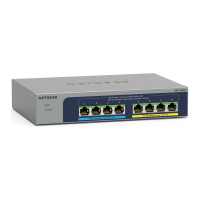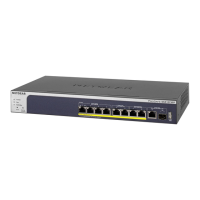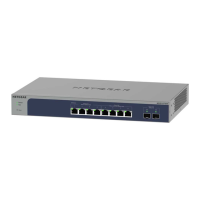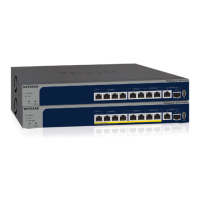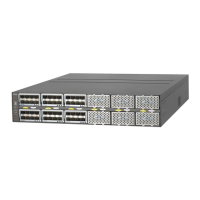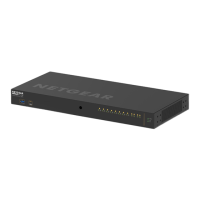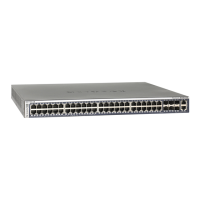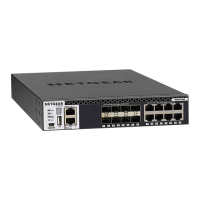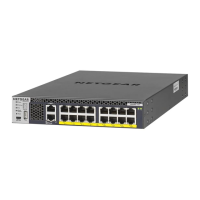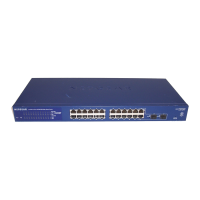Do you have a question about the NETGEAR MS108EUP and is the answer not in the manual?
Provides links to additional product documentation.
Lists the items included in the switch's packaging.
Identifies the specific switch model covered by this manual.
Explains the meaning and function of the switch's LED indicators.
Describes the information found on the switch's physical label.
Details crucial safety precautions for using the switch.
Guides on physically connecting and powering on the network switch.
Explains methods to find the switch's IP for accessing its interface.
Details how to configure a static IP for consistent network access.
Allows users to select their preferred language for the switch interface.
Instructions for enhancing security by changing the default password.
Explains the process for registering the switch for support and updates.
Configure QoS and rate limits to manage network traffic and prioritize data.
Customize settings for each port, including speed, flow control, and naming.
Introduces Virtual LANs and their role in network segmentation.
Steps to enable basic VLANs and assign ports to specific VLANs.
Detailed configuration for advanced port-based VLAN setups.
Guide to creating and managing VLANs using the 802.1Q standard.
Advanced configuration options for 802.1Q VLANs, including tagging.
Procedures to disable VLAN modes and remove all configured VLANs.
Configure the protocol used for discovering NETGEAR devices on the network.
Combine multiple ports for increased bandwidth and fault tolerance.
Optimize multicast traffic flow using IGMP snooping and other features.
Steps to assign a static IP address to the switch.
Restore the switch to obtaining an IP address automatically via DHCP.
Instructions for manually updating the switch's firmware to the latest version.
Backup and restore switch configuration settings.
Guide to resetting the switch to its original factory configuration.
Restrict or allow access to the switch management interface by IP address.
Configure secure (HTTPS) and standard (HTTP) access to the switch UI.
Modify or remove IP-based access controls for the switch UI.
Enable Denial of Service protection to block malicious network traffic.
Configure energy-efficient features to reduce power consumption.
Enable or disable the status lights on the switch ports.
Customize the name identifying the switch on the network.
Access details like firmware version, MAC address, and serial number.
Configure manual time settings or synchronize with an SNTP server.
Display information about active network connections on the switch.
Check the operational status and statistics for individual network ports.
Manage and monitor Power over Ethernet (PoE) functionality on the switch.
Utilize a built-in feature to diagnose network cable health and faults.
Troubleshoot IP address conflicts to ensure network accessibility.
Guidance for resolving common issues with Power over Ethernet (PoE) connections.
Configure network loop detection to prevent broadcast storms.
Mirror network traffic from specified ports for monitoring and analysis.
Access and reset traffic counters and error logs for each port.
Details the default configuration parameters of the switch.
Provides hardware and performance specifications for the switch model.
Instructions on how to locate and connect to the switch from any network device.
Provides links to additional product documentation.
Lists the items included in the switch's packaging.
Identifies the specific switch model covered by this manual.
Explains the meaning and function of the switch's LED indicators.
Describes the information found on the switch's physical label.
Details crucial safety precautions for using the switch.
Guides on physically connecting and powering on the network switch.
Explains methods to find the switch's IP for accessing its interface.
Details how to configure a static IP for consistent network access.
Allows users to select their preferred language for the switch interface.
Instructions for enhancing security by changing the default password.
Explains the process for registering the switch for support and updates.
Configure QoS and rate limits to manage network traffic and prioritize data.
Customize settings for each port, including speed, flow control, and naming.
Introduces Virtual LANs and their role in network segmentation.
Steps to enable basic VLANs and assign ports to specific VLANs.
Detailed configuration for advanced port-based VLAN setups.
Guide to creating and managing VLANs using the 802.1Q standard.
Advanced configuration options for 802.1Q VLANs, including tagging.
Procedures to disable VLAN modes and remove all configured VLANs.
Configure the protocol used for discovering NETGEAR devices on the network.
Combine multiple ports for increased bandwidth and fault tolerance.
Optimize multicast traffic flow using IGMP snooping and other features.
Steps to assign a static IP address to the switch.
Restore the switch to obtaining an IP address automatically via DHCP.
Instructions for manually updating the switch's firmware to the latest version.
Backup and restore switch configuration settings.
Guide to resetting the switch to its original factory configuration.
Restrict or allow access to the switch management interface by IP address.
Configure secure (HTTPS) and standard (HTTP) access to the switch UI.
Modify or remove IP-based access controls for the switch UI.
Enable Denial of Service protection to block malicious network traffic.
Configure energy-efficient features to reduce power consumption.
Enable or disable the status lights on the switch ports.
Customize the name identifying the switch on the network.
Access details like firmware version, MAC address, and serial number.
Configure manual time settings or synchronize with an SNTP server.
Display information about active network connections on the switch.
Check the operational status and statistics for individual network ports.
Manage and monitor Power over Ethernet (PoE) functionality on the switch.
Utilize a built-in feature to diagnose network cable health and faults.
Troubleshoot IP address conflicts to ensure network accessibility.
Guidance for resolving common issues with Power over Ethernet (PoE) connections.
Configure network loop detection to prevent broadcast storms.
Mirror network traffic from specified ports for monitoring and analysis.
Access and reset traffic counters and error logs for each port.
Details the default configuration parameters of the switch.
Provides hardware and performance specifications for the switch model.
Instructions on how to locate and connect to the switch from any network device.
| Switch type | Managed |
|---|---|
| Switch layer | L2/L3 |
| Quality of Service (QoS) support | Yes |
| Installed SFP modules quantity | - |
| Basic switching RJ-45 Ethernet ports type | 2.5G Ethernet (100/1000/2500) |
| Basic switching RJ-45 Ethernet ports quantity | 8 |
| 10G support | No |
| Number of VLANs | 64 |
| Networking standards | IEEE 802.1Q, IEEE 802.1p, IEEE 802.3, IEEE 802.3ab, IEEE 802.3ad, IEEE 802.3af, IEEE 802.3at, IEEE 802.3az, IEEE 802.3bt, IEEE 802.3u, IEEE 802.3x |
| Virtual LAN features | Port-based VLAN, Tagged VLAN |
| Copper ethernet cabling technology | 100BASE-T, 1000BASE-T |
| Jumbo frames | 12000 |
| MAC address table | 16000 entries |
| Packet buffer memory | 1.5 MB |
| DHCP features | DHCP client |
| Queue scheduling algorithms | Strict Priority Queue (SPQ), Weighted Round Robin (WRR) |
| Number of multicast groups filtered | 128 |
| Operating altitude | 0 - 3000 m |
| Storage temperature (T-T) | -20 - 70 °C |
| Operating temperature (T-T) | 0 - 40 °C |
| Storage relative humidity (H-H) | 0 - 95 % |
| Operating relative humidity (H-H) | 0 - 90 % |
| Total Power over Ethernet (PoE) budget | 230 W |
| Power source | PoE |
| Mean time between failures (MTBF) | 373644 h |
| Certification | CE FCC 15 B CE/EN55032/24 CSA VCCI ACMA KC CCC BSMI |
| Product color | Gray |
| Housing material | Metal |
| Depth | 140 mm |
|---|---|
| Width | 210 mm |
| Height | 40 mm |
| Weight | 900 g |
